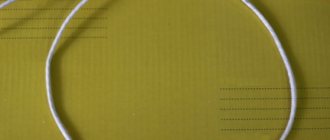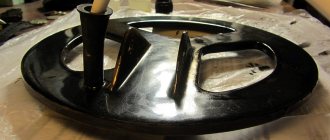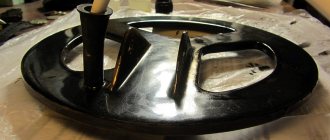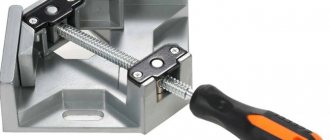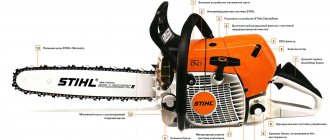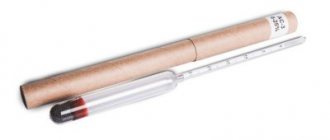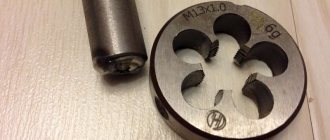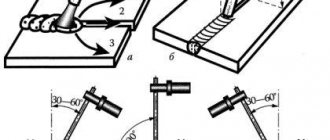Coming to a cop and finding problems with the metal detector is sad... You stand in the middle of a field, waving the detector like a fool, listening to wild songs. When traveling by car over 100 km, I keep at least 2 detectors in the trunk. If you are a travel companion, you always have a second coil in your backpack. My spare coil has already helped the comrades continue their digging several times.
Let's look at a step-by-step list of what to do if the metal detector coil is faulty.
An example of how this happens (not mine):
Metal detector or not?
If you have phantoms, start by replacing the power supply . For example, in Garrett ACE or Garrett AT PRO, discharged batteries will give the effect of chaotic operation (at the same time, the battery icon on the screen still shows one dash).
Next, you need to understand whether the metal detector is faulty here, or in general . In such cases, I reset the metal detector to factory settings, lift the coil into the air, and eliminate the influence of the ground (and the contact of the coil).
We look at the power lines. We move away from the point by 50-100 meters. Along the way, we get rid of electromagnetic emitters - we throw away mobile phones (just kidding, I turn off the data connection and put the phone in a backpack).
Simple metal detectors from ready-made electrical appliances
- A metal detector can be made from a radio receiver by adding a simple HF transmitter to it:
The search coil is wound from 0.5 mm² wire: 16 turns 12 cm. When a metal object enters the range of action, a receiver tuned to the MW/LW range will change the tone of the sound. - A homemade metal detector made from a cell phone is nothing more than a myth. Upgrading its electrical circuit at home is not feasible, and it is technically impossible to make a standard mobile phone work as a metal detector.
- In fact, there is no need to make a metal detector out of a magnet. You simply bring a powerful neodymium magnet to the place where there is a metal object and physically feel the force of attraction. Of course, this only works with metals that have ferromagnetic properties (iron, steel).
Reel or block
Where is the problem - in the coil or the detector unit ? Checked by replacing the coil. If the other coil works normally, then your metal detector unit is working properly. The problem is in the coil. Moreover, the coil is not necessarily the same, we need to check the unit, and any coil from this detector will do.
I know that many people have nowhere to get another reel. In such cases I did this...
I came with the block to a metal detector store. Like, I'm choosing a coil for my detector. A legitimate desire is to check with your metal detector.
Types of metal detectors
There is a wide range of metal detectors on the market, used in many areas. Below is a list that shows some of the varieties of these devices:
Ground model Deep metal detector Underwater vehicle Security device Industrial metal detector
- Ground. These devices are designed for searching with your own hands for scrap metal, jewelry, coins, etc.
- Deep. These devices are used to search for the above-mentioned metal products at great depths.
- Underwater. Devices of this type are designed to operate underwater. They can work at different depths.
- Metal detectors for searching for gold. These devices allow you to find gold and gold jewelry in any environment.
- Security devices. These devices are used to detect metal products on the human body and in luggage. Such devices are made in the form of arches and are installed at the entrance to places with large crowds of people, for example, at train stations, shopping centers, etc.
- Industrial. This equipment is part of conveyor lines. Their main task is to detect metal in other substances. For example, in a mined sand-soil mixture.
- Army. The military uses such devices to detect mines, unexploded shells, bombs, etc. with their own hands. The military calls such devices mine detectors.
- Do-it-yourself devices are most often assembled by novice “treasure hunters”.
The use of modern materials allows us to design and manufacture devices with high accuracy in detecting metals in different environments. The use of microelectronics has made it possible to minimize their overall weight parameters. In addition, the simplicity of the electrical circuit allows you to make a metal detector with your own hands at minimal cost.
Related coil problems
If there is protection on the coil, remove it. Often moisture and soil accumulate under the protection. This is especially true on the sea beach. I was surprised how much was packed under it (the salty sand was protected, it was still a surprise).
Important point. Problems often have an accompanying factor that must be taken into account... For example, you are digging in the heat, after an hour problems began - the coil got hot, the fastening of the circuits lost their properties, and the circuits began to tremble inside - as a result, phantoms.
Or you mow with a coil in dew, after 30 minutes you start to see phantoms - there is a high probability that moisture has appeared in the coil. If you can look at the companion, it will be easier to identify the problem.
Seeker "Chance"
A similar circuit on the ATmega8 controller is called “Chance”. The principle of operation is similar, only the possibility of screening out (partial discrimination) of ferrous metals has become possible.
A printed circuit board design has also been worked out, which can be successfully replaced with a classic “breadboard” for Arduino
Coil problems
Problems The metal detector coil is conventionally divided into 4 zones: connector, cable, cable outlet from the coil, and the coil itself.
Sometimes the problem is on the surface and easy to detect. You pull the connector, bend the cable, move the cable lead out of the reel. But there are worse cases...
Sudden loss of depth . The coil sees targets only at point blank range. For example, a nickel E2 up to 5 centimeters. One circuit is torn off. Look where (connector, cable, output from the coil).
The coil does not see silver or large copper. The coil is not tuned (defective). Please note this may be the case on certain settings. For example, frequency shift when detuning from interference.
Phantoms when shaken in the air. There may be either a cable or loss of circuit attachment points inside. In this case, I would try to tap the coil, while trying to keep the wire still. If there is a wire, the repair is easier. If the circuit is not fastened inside (for example, it breaks off from a side impact, or softens in the heat), you cannot do without opening the filling.
Components for assembling the electronic circuit of the Pirate metal detector on K561la7
- Used capacitors are often used, but their capacity must be checked. Ceramic elements work well. To make the circuit you will need the following parts: 100 uF – 1 pc.; 1000 pF – 3 pcs.; 22 pF – 2 pcs.; 300 pF – 1 pc.
- Used fixed resistors are also used by removing them from old circuits. They retain their quality characteristics for many years. 22 Ohm – 1 pc.; 1 kOhm – 1 pc.; 4.7 kOhm – 1 pc.; 10 kOhm – 1 pc.; 470 kOhm – 1 pc.
- It is better to buy variable resistors in an electrical supermarket or at a radio market: 1.5 kOhm - 1 pc., 20 kOhm - 1 pc.
- The K561la7 chip is housed in a protective DIP format housing. The legs are numbered from the notch on the chip body, starting counterclockwise.
- The KT-315 transistor can be replaced with KT3102, BC546, or similar low-frequency elements with similar characteristics. Looking at the front part of the transistor, the terminals are distinguished, from right to left - emitter, collector and base.
- The diode can be selected from such radio components as: kd522B, kd105, kd106. Before soldering, the diode must be ringed in order to accurately distinguish the anode from the cathode.
- You can use headphones from an mp3 player or something similar as a signaling device.
- Power supply: 9 V Krona battery. and contact group.
Lesson 6. Magnets using papier-mâché technique
To create such magnets, you can use not only old newspapers and magazines. In the same way, you can create a collage from postcards or photographs.
You will need:
- magnets;
- round stamp with a diameter of 2.5 cm (or scissors);
- pieces of colored paper or clippings from magazines and newspapers;
- glue;
- double-sided adhesive tape;
- thin cardboard.
Cut out circles with a diameter of 2.5 cm from thin cardboard, and apply double-sided adhesive tape to each.
Cut colored paper or magazine clippings into small pieces and start gluing them onto cardboard circles, placing the pieces close to each other, sometimes gluing one on top of the other. Trim the overhanging edges to give them a smooth round shape, then cover the pieces with one or two layers of glue and leave to dry.
Glue a magnet on the back side. Ready!
Master class No. 2
You will need:
- wine bottle caps;
- magnets;
- some soil and small plants;
- hot glue gun, knife and screwdriver.
1: Use the tip of a screwdriver to make a small hole at the top of the plug. Using a knife, widen and deepen this hole. Work carefully, do not pierce the “walls” of the cork all the way through. The hole should reach approximately half the depth of the plug.
Using a hot glue gun, glue a magnet to the cork.
2: Fill the hole with soil and plant the plants.
Tip: Remember to water the plants regularly, and when they take root, transplant them into a larger pot.
Idea No. 9
Now let’s make the pinch magnets. You will need:
- wooden clothespins;
- magnetic tape;
- glitter;
- acrylic paint and a thin brush.
Decorate the clothespin with glitter or paint it with acrylic paint, then stick a small piece of magnetic tape on the back side. Simple and original!
How to make a metal detector with your own hands with metal discrimination
Metal discrimination is the ability of the device to distinguish between the detected material and classify it. Discrimination is based on different electrical conductivities of metals. The detector's processor analyzes the phase shift between the signals of the two coils and not only distinguishes non-ferrous metals from ferrous metals, but can recognize whether it is copper, gold or silver. The simplest discrimination process is implemented in pulsed devices. They are able to find and distinguish non-ferrous from ferrous metal.
Professional models are equipped with programmable “brains” that are capable of sending a signal only to the desired object, without distracting the operator with other finds
For your information! No matter how professional the device is, do not expect one hundred percent results from it. Many materials have similar electrical conductivity, so the machine can make mistakes.
Detailed information on assembling such a detector is in the video.

